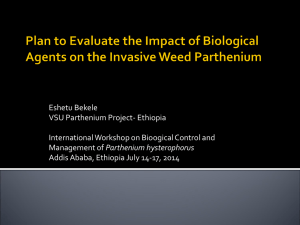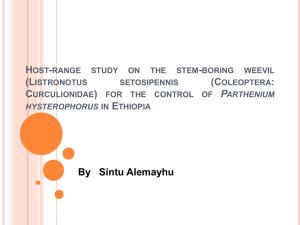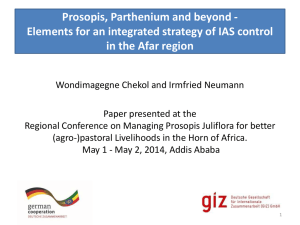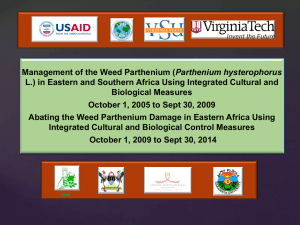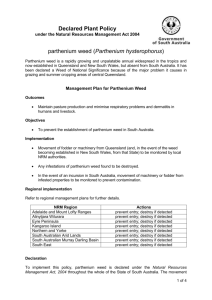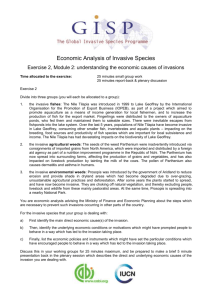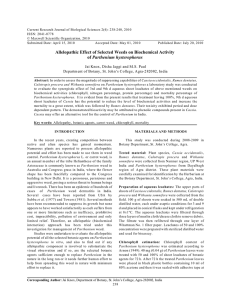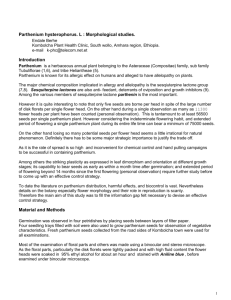A Dreaded Weed - Pankajoudhia.com
advertisement
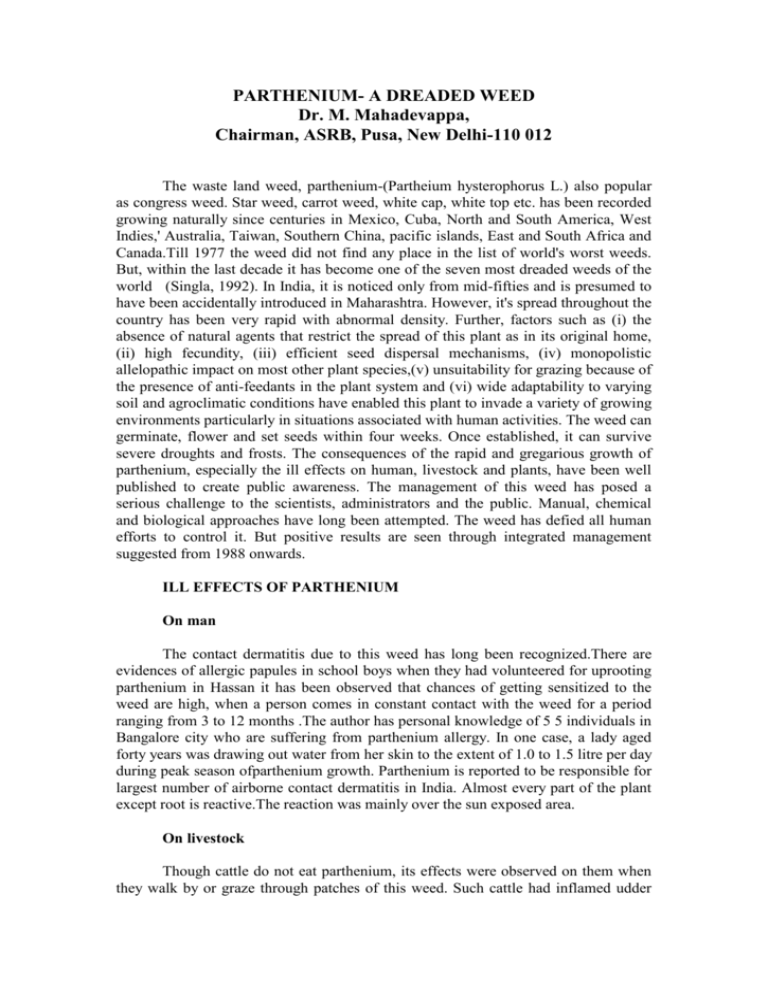
PARTHENIUM- A DREADED WEED Dr. M. Mahadevappa, Chairman, ASRB, Pusa, New Delhi-110 012 The waste land weed, parthenium-(Partheium hysterophorus L.) also popular as congress weed. Star weed, carrot weed, white cap, white top etc. has been recorded growing naturally since centuries in Mexico, Cuba, North and South America, West Indies,' Australia, Taiwan, Southern China, pacific islands, East and South Africa and Canada.Till 1977 the weed did not find any place in the list of world's worst weeds. But, within the last decade it has become one of the seven most dreaded weeds of the world (Singla, 1992). In India, it is noticed only from mid-fifties and is presumed to have been accidentally introduced in Maharashtra. However, it's spread throughout the country has been very rapid with abnormal density. Further, factors such as (i) the absence of natural agents that restrict the spread of this plant as in its original home, (ii) high fecundity, (iii) efficient seed dispersal mechanisms, (iv) monopolistic allelopathic impact on most other plant species,(v) unsuitability for grazing because of the presence of anti-feedants in the plant system and (vi) wide adaptability to varying soil and agroclimatic conditions have enabled this plant to invade a variety of growing environments particularly in situations associated with human activities. The weed can germinate, flower and set seeds within four weeks. Once established, it can survive severe droughts and frosts. The consequences of the rapid and gregarious growth of parthenium, especially the ill effects on human, livestock and plants, have been well published to create public awareness. The management of this weed has posed a serious challenge to the scientists, administrators and the public. Manual, chemical and biological approaches have long been attempted. The weed has defied all human efforts to control it. But positive results are seen through integrated management suggested from 1988 onwards. ILL EFFECTS OF PARTHENIUM On man The contact dermatitis due to this weed has long been recognized.There are evidences of allergic papules in school boys when they had volunteered for uprooting parthenium in Hassan it has been observed that chances of getting sensitized to the weed are high, when a person comes in constant contact with the weed for a period ranging from 3 to 12 months .The author has personal knowledge of 5 5 individuals in Bangalore city who are suffering from parthenium allergy. In one case, a lady aged forty years was drawing out water from her skin to the extent of 1.0 to 1.5 litre per day during peak season ofparthenium growth. Parthenium is reported to be responsible for largest number of airborne contact dermatitis in India. Almost every part of the plant except root is reactive.The reaction was mainly over the sun exposed area. On livestock Though cattle do not eat parthenium, its effects were observed on them when they walk by or graze through patches of this weed. Such cattle had inflamed udder and subsequently suffered from fever and rashes. It is reported that feeding the weed to buffalo and bullcalves at different levels causes both acute and chronic forms of toxicity.Ulcerations were caused both in the mouth and digestive tract. Autopsy of the dead animals showed punched cut ulcers on the oesophagous and the obosomal folds. Histopathology of the kidney and liver revealed degenerative changes and necrosis. It was reported that "Labelled parthenium" was found to be excreted in the milk when administered to lactating guinea pigs, rabbits and cow. Consumption of milk from the livestock grazing around parthenium invaded freezing land could be hazardous to man. ILL-EFFECTS OF POLLEN Ever since the parthenium weed started invading newer areas in high population, its numerous ill effects on human beings and cattle have been reported in plenty. But no systematic studies have been made to know which part of the plant is dangerous to human and animal life. A few studies carried out in Delhi revealed that parthenium pollens were observed in the atmosphere throughout the year and that the pollen of parthenium showed marked positive skin reactions (2+ and 3+) in 14 out of 50 patients. They observed that flower extracts stand next to pollen in allergenicity. The flower extract showed positive skin reactions in 3 (6 per cent) out of 50 patients, closely followed by leaf extract (2 out of 50). A detailed survey of atmospheric pollen conducted by Subba Rao (1984) in Bangalore indicated varying amount of pollen grain either singly or in clumps through out the year but in abundance in the month of June and August. In a study carried out at Jaipur on the allergenic disorder caused by allergens on 100 people, it has been indicated that nearly 50 per cent of the population developed asthma, 16 to 17 per cent with urticaria and rhinitis, while only 4 per cent of the people developed dermatitis (Krishna Murthy et al., 1977) The people in the age group of 21 to 30 years suffered largely (by 21 per cent) followed by 11 to 20 years (by 11 per cent) (Kasliwal et al.,1961). The pollen of this weed have been observed to cause allergic rhinitis in Argentina (Castex et al.,1940) and Mexico (Femandez,1942) but not in North America (Wood House, 1971). In a pollen study at Bangalore, Kanchan and Jayachandra (1976a) observed the weed to produce an average of 624 million pollens per plant and these were carried to distant places in clusters of 600-800 grains each. The pollen is also reported to have allelopathic activity and has inhibited development of fruits in brinjal, tomato, chilli when artificially disted on stigmatic surface of these plants. Further accumulation of 100-150 clusters of parthenium pollen on floral parts of maize caused 50 per cent reduction in grain filling. USE AND MISUSE OF PARTHENIUM Parthenium has been regarded as a beneficial plant too, inspite of its ill effects which outweigh its uses. It is used as a folk remedy against various afflictions such as ulcerated sores, certain skin diseases, facial neuralgia, fever and anaemia dysentery, cleaning the blood and also as insecticide. Study made at the Cancer Research Institute, Mumbai has indicated that "parthenin", the principal ingredient, of this plant possesses anticancer properties. Of late parthenium plants have been commonly used as centering material in the construction of buildings and bridges. Further, studies at the Indian Institute of Science, Bangalore have indicated a possibility that parthenium plants can be ensilaged after mixing it in certain proportion with conventionally used feeds. It is reported that parthenium could be detoxified by ensilation i.e., anaerobic fermentation by packing chaff-cut weed in trenches along with small quantities of salt and allowing to ferment for 2 to 3 months. The silo thus obtained was reported to be devoid of the contact allergen/toxin parthenium and was palatable to live stock and was comparable to the well known fodder silos with high nutritive value. The fibrous nature of the parthenium stem is a point that needs the attention of industrial researchers to see if it has potential in manufacturing paper and such other materials as helmet, moulded furniture, door etc. Some people out of ignorance or otherwise are using parthenium flowers for preparations of bouquets in flower vases etc. The weed is also used as firewood, as green manure in rice fields and as packing material for fruits. The leaves of parthenium which have close resemblance to those of "Davana" (Artemisia pollens Wall) are mixed with it and sold. Parthenium leaves are also seen bundled with coriander leaves and sold in the vegetable market. In the years of drought when most plant species fail to grow, parthenium by virtue of tolerance to drought grows and brings down Co2 level in this atmosphere. It is reported that 20 per cent parthenium leaf water extract when sprinkled on mulberry leaves improved the quality as well as quantity of cocoon due to steroids present in the parthenium plant. As felt at present, its harmful effects both from medical as well animal health and agricultural production point of view are serious matters for consideration. INTEGRATED MANAGEMENT OF PARTHENIUM The adaptive research carried out jointly by the university of agricultural sciences Bangalore and programme for parthenium elimination (Propel), Bangalore, in and around Bangalore city for five years commencing from 1986, involved employment of different control methods individually and in combinations over large areas. The studies clearly demonstrated that only an integrated approach now termed "Integrated Parthenium Weed Management (IPWM)" involving the various methods suggested in the past can be effective in controlling parthenium. If a concerted effort is made to adopt IPWM, the results will be visible in the second year and by the third year the parthenium will come down to a negligible level. The newly suggested IPWM envisages five steps viz., (i) Maintenance of natural biodiversity i.e., not to disturb the existing flora to the extent possible, (ii) In places where cleaning and exposing of soil is unavoidable, planting of C. sericea or such other plant species (proven botanical agents-BAS) at the start of rainy season. The growth of such plants can insulate opened upsoils against invasion by parthenium. In already infested areas, planting of BAS may be taken up at the start of rainy season and parthenium plants which may grow along with BA are to be removed in the first one or two years, so that the antagonistic plant establishes well. Afterwards, there will be no need to plant BA again as it will perpetuate on its own. (iii) To watch for the commencement of rains and build up of Mexican beetles (Zygogramma) and when the beetles become available in large numbers, they have to be collected and released in parthenium invaded areas. (iv) In situations where none of the above methods can be adopted as in case of gardens, flowers beds, lawns intensively cultivated agricultural fields, manual removal has to be taken up. In the manual method, it should be noted that the persons chosen for uprooting the weed should not be allergic to parthenium. (v) In situations where none of the above methods can be adopted like vast stretches of already parthenium invaded plots and where immediate relief is needed, it may have to be controlled through checmical sprays with the knowledge that it gives only temporary suppression and does not ensure permanent control. Further, as chemical method causes environmental pollution, it is recommended onlyas a last resort, wherever emergent situations arise for clearing parthenium populations. The last two methods can also be integrated initially with biological methods in order to achieve desired results faster. The proven botanical agents are: Cassia sericea SW (Syn: Cassia uniflora). Cassia tora LK., Cassia auriculata L., C. occidentale Croton bonplandiamum Baill, (Syn: C. sparsiflorus Morong) Amaranthus spinosus L., Tephrosia purpurea Pers., Hyptis suaveolens Poit, Sida spinosa L„ and Mirabilis Jalapa L., Stylosanthus hamata, Tagetes Erecta. Pay special attention to protect and promote the growth of the above plant species which exist in the waste lands in natural course.
